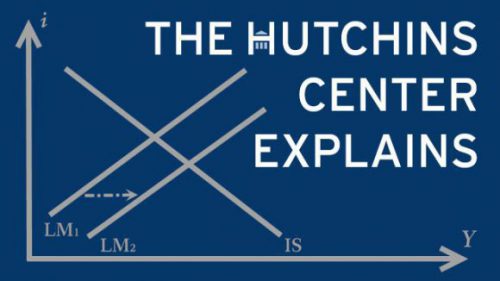Swap lines are arrangements under which the Federal Reserve lends foreign central banks U.S. dollars so they can supply them to foreign financial institutions. They were key to the Fed’s efforts to stabilize financial markets during the Global Financial Crisis and at the start of the COVID pandemic. There is concern among some foreign officials that the Fed might not be willing to provide dollar liquidity in future crises. This post explains how Fed swap lines work.
How does a Fed swap line work?
The Fed lends U.S. dollars to a foreign central bank at an interest rate based on the overnight index swap plus a spread. The loans are collateralized by the currency of the foreign central bank; when the loan of dollars is repaid, the Fed returns the foreign currency. The foreign central bank takes the credit risk for lending to one of its financial institutions, not the Fed. For example, at the onset of the COVID pandemic, on March 18, 2020, the European Central Bank drew $36.3 billion at an interest rate of 0.45% with a term of seven days. (Here is a searchable list of all Fed swap lines.)
Why does the Fed do this?
The Fed is the lender of last resort to solvent banks in the U.S., providing them with liquidity when they can’t get it elsewhere, so they can stay in business and keep lending. Foreign banks have both dollar assets and dollar liabilities. Although their central banks can easily supply their own currencies to banks by lending to them, they can’t supply dollars beyond the central bank’s reserves. At times of stress, foreign financial institutions may need to sell dollar-denominated assets on world markets, which can be disruptive and can drive dollar interest rates higher. To avoid that, the Fed indirectly acts as a lender of last resort for dollars to foreign banks as well.
What is the history of Fed swap lines?
Under the Bretton Woods monetary arrangement in the 1950s and 1960s, U.S. dollars were convertible to gold at a fixed exchange rate, and other currencies were tied to the dollar. Throughout this period there were periodic currency crises, reflecting doubts about the stability of some currencies to the dollar and of the dollar to gold. Concerns about the stability of the dollar-gold price were fed by the growth of global dollar liabilities well above the value of the U.S. gold stock. To prevent a run on the dollar, the Federal Reserve established the Reciprocal Currency Arrangements—a network of temporary swap lines—with foreign central banks. By the end of 1962, the Fed had set up lines with central banks of nine large economies, and between 1962 and 1969, Fed swap drawings totaled $7 billion.
In addition, swap lines have been used to supplement dollar reserves of foreign central banks during crises, such as a 1967 swap line with Mexico. The swap line with Mexico was made permanent (along one with Canada) in 1994, as part of the treaty that established a free trade area on the continent.
The swap lines were utilized several times in the 2000s. Many foreign banks had invested in U.S. mortgage-backed securities in the run-up to the GFC. When the housing bust undermined the value of those securities, some foreign banks had difficulty rolling over dollar loans, adding to the stress in global financial markets. In response, the Fed in December 2007 launched swap lines with several central banks of large economies, as well as with a few emerging economies (such as Brazil and Singapore) considered to have strong institutions and be critical to global markets. In December 2008, outstanding swap drawings reached their peak at over $580 billion, which was approximately 25% of the Federal Reserve’s total assets. These swap lines were terminated in February 2010, but renewed in May 2010 due to the re-emergence of strains in U.S. dollar funding in international markets. In October 2013, the Fed and five other central banks announced that these temporary swap lines would be converted to standing arrangements, meaning that the lines are in place on a continual basis.
In March 2020, at the onset of the COVID pandemic, many investors were trying to build cash by selling dollar securities, including U.S. Treasury debt. To encourage use of the swaps to maintain market stability, the Fed reduced the cost of borrowing by lowering the spread of its swaps relative to overnight indexed swaps. It also opened temporary swap lines with nine other central banks that had them during the GFC, but not on a standing basis. Peak usage during the COVID-19 pandemic was in May 2020, a total of $470 billion. About 80% of this was loaned to the European Central Bank and the Bank of Japan.
How effective are swap lines?
The effectiveness of central bank swap lines can be evaluated in three main ways. First, by providing foreign central banks with a direct source of U.S. dollars, the swap lines cap the interest rate that private markets can charge for dollar borrowing. Second, the availability of these dollars increases the liquidity of dollar assets, and with the assurance of the Fed acting as a lender of last resort, it makes foreigners more willing to invest in U.S. dollar-denominated assets. Finally, the swap lines help to bring exchange rates between foreign currencies and the dollar closer to the covered interest parity, which is the no-arbitrage exchange rate. In practice, this means that the forward exchange rate adjusts so differences in interest rates across countries don’t allow investors to arbitrage.
For example, in 2011, according to Ricardo Reis of the London School of Economics, the swap lines reduced the interest rate for borrowing U.S. dollars by 50 basis points, which led European financial institutions to increase their holdings of U.S. Treasury securities. Similarly, during the COVID-19 pandemic, the swap lines were effective in bringing exchange rates closer to the covered interest parity level, according to academic researchers.
Given the demand for cash during the onset of the pandemic, foreign holdings of U.S. Treasuries fell significantly, adding to the pressure in U.S. Treasury markets; foreign investors sold about $150 billion in March 2020 and another $70 billion in April 2020. The Federal Reserve created the FIMA repo facility in March 2020, which became a standing facility a year later. The facility allows central banks with FIMA accounts at the Federal Reserve Bank of New York to borrow against their Treasuries, thereby turning their Treasuries into cash without selling them in the open market.
Why are foreign central bankers worried about the swap lines?
Fed Chair Jerome Powell has said that the Fed stands ready to lend dollars to foreign central banks. But his term as Fed chair ends May 15, 2026, and President Trump will pick his successor.
There are reports—on Reuters and in the Financial Times—that foreign central bankers are starting to ask if the post-Powell Fed will be as willing to lend them dollars as they were during the GFC and COVID.
What alternatives have been proposed?
“What if some future Fed leadership were to decline to extend its credit through central bank swaps?” Robert N. McCauley, a non-resident fellow at Boston University’s Global Development Policy Center, asked in a May 2025 post. His suggestion: 14 major central banks with substantial dollar holdings agree to lend to each other, rather than relying on the Federal Reserve. This is similar to the Chiang Mai Initiative between Southeast Asian countries, where foreign reserves are pooled to defend against speculative attacks.
However, during a crisis, this would require these central banks to liquidate their dollar reserves, often invested in U.S. Treasuries. Such large-scale sales could disrupt the bond market, potentially forcing the Federal Reserve to intervene as a “purchaser of last resort” or to cap market repo rates. Consequently, even with such a coalition, coordination between the Fed and the central bank coalition would still be needed.
What about countries that don’t have Fed swap lines?
For countries without access to Fed swap lines, the International Monetary Fund offers three backstop facilities. The Flexible Credit Line (to be repaid over three to five years) and the lower-cost Short-Term Liquidity Line (to be repaid in 12 months) are no-questions-asked loans available to countries with “very strong economic fundamentals and institutional policy frameworks.” The Precautionary and Liquidity Line is available to countries with sound economic fundamentals but with some remaining vulnerabilities that preclude them from using the Flexible Credit Line. For a variety of reasons, participation in these facilities has been low.
The Brookings Institution is committed to quality, independence, and impact.
We are supported by a diverse array of funders. In line with our values and policies, each Brookings publication represents the sole views of its author(s).






Commentary
What are Federal Reserve swap lines?
August 21, 2025